Cuprite, Cu2O, Cubic, Pn3m
< Specimens No. IV-1—No. IV-24 >
Specimens No. IV-1—No. IV-11, from the Arakawa Mine, Akita Pref., occur as secondary product in an oxidized copper deposit. Cuprite in these specimens is either capillary aggregates or granular crystals in the form of cube, octahedron or their combination, and intimately associated with native copper, malachite and chryso-colla.
Specimen No. IV-12, from the Kisamori Mine, Akita Pref., occurs as oxidation product in an epithermal copper deposit, forms aggregates of crystals octahedral, cubic or cubo-octahedral, and is associated with native copper.
Specimens No. IV-13—No. IV-20, from the Hisaichi Mine, Akita
Pref., are an oxidation product in an epithermal copper deposit, occur in
fractures of a chalcopyrite-pyrite-chlorite-quartz vein or its country rocks,
and form aggregates of fine acicular crystals or cube-shaped crystals with
a(100) and o(111). Crystals different in habit coexist in one specimen. Secondary
minerals intimately associated with cuprite are native copper, malachite and
earthy limonite. Cuprite showing acicular habit is given the variety name
"chalcotrichite" and forms strawbery-red capillary aggregates (Plate 8).
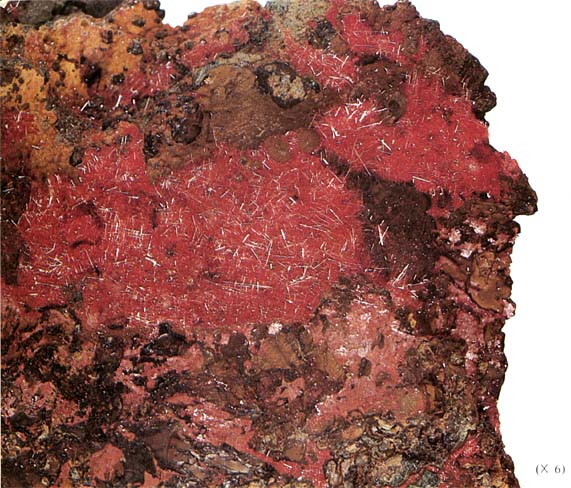
CUPRITE (No. IV-14) Hisaichi Mine, Akita Pref
Specimen No. IV-21, from the Nabeto Mine, Ishikawa Pref., occurs in an oxidized zone of an epithermal chalcopyrite-bearing quartz vein in association with dendritic aggregates of native copper and crystals of barite, and forms octahedral crystals up to 1 mm in diameter.
Specimen No. IV-22, from the Ogoya Mine, Ishikawa Pref., occurs in fractures of quartz in an oxidized epithermal copper deposit, and forms massive aggregates of octahedral crystals attaining a few millimeters in diameter.
Specimens Nos. IV-23 & IV-24, from the Yamato (Ofuku) Mine, Yamaguchi Pref., occur in an oxidized zone of a contact copper deposit, and form massive aggregates of acicular as well as granular crystals.
Magnetite, Fe3O4, Cubic, Fd3m
< Specimens No. IV-25—No. IV-40 > (Fig. 54)
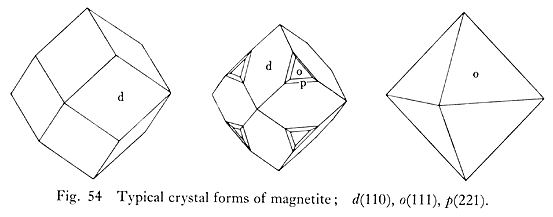
Specimen No. IV-25, from Onnenai, Hokkaido,, occurs as pebbles from a placer gold deposit.
Specimens No. IV-26—No. IV-31, from the Kamaishi Mine, Iwate
Pref., occur as massive aggregates of granular crystals in andradite-epidote
masses in a contact iron deposit. The crystal forms are octaheral or rhombic
dodecahedral with d(110) and o(111) (Fig. 55).
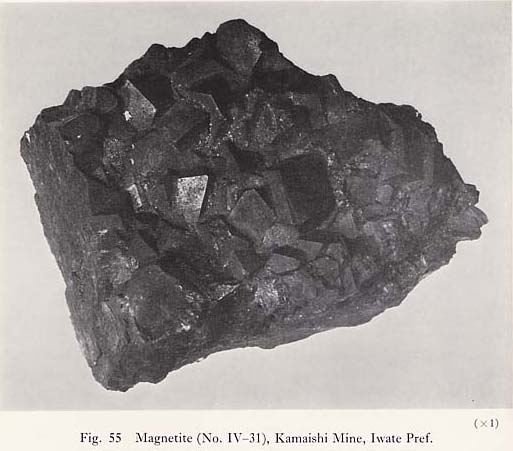
Specimen No. IV-32, from the Chichibu Mine, Saitama Pref., occurs in a contact iron deposit, and forms massive aggregates of granular crystals rhombic dodecahedral with d(110).
Specimens Nos. IV-33 & IV-34, from Nakatsugawa, Saitama Pref., occur in a contact iron deposit as massive aggregates of granular crystals in association with prismatic crystals of actinolite. The size of the octahedral crystals is up to 8 mm in diameter.
Specimens No. IV-35—No. IV-37, from Wanabasawa of the Chichibu Mine, Saitama Pref., occur in a contact iron deposit as aggregates of granular crystals rhombic dodecahedral with d(110), and are associated with a small amount of calcite.
Specimen No. IV-38, from Ogushi, Nagasaki Pref., occurs as porphyroblasts in green schist and forms octahedral crystals attaining 8 mm in diameter.
Specimen No. IV-39, from the Hongeiko Mine, China, occurs in a contact iron deposit as massive aggregates of granular crystals.
Specimen No. IV-40, from the Kyuchorei Mine, China, occurs as isolated octahedral crystals from a contact iron deposit. The largest crystal measures 1 cm in diameter.
Koechlinite, Bi2MoO6, Rhombic, Cmca
< Specimens Nos. IV-41 & N-42 >
Specimens Nos. IV-41 & IV-42, is from the Ebisu Mine, Gifu Pref. See bismuth (No. I-72).
Corundum, α-Al2O3, Trigonal, R![]() c
c
< Specimens No. IV-43—No. IV-45 >
Specimen No. IV-43, from the Ishikawa District, Fukushima Pref., occurs in a stream sediment derived from a granitic pegmatite, and is greyish blue hexagonal platy crystals about 7 mm across.
Specimen No. IV-44, from Yagenyama, Naegi District, Gifu Pref., occurs in a pneumatolytically altered granite, is associated with protolithionite, muscovite and feldspar, and forms hexagonal tabular crystals attaining about 5 mm in diameter. It shows pale blue colour.
Specimen No. IV-45, from Transvaal, South Africa., occurs in a placer deposit, and forms yellowish brown coloured six-sided crystals elongated into a tapered bipyramid.
Hematite, α-Fe2O3, Trigonal, R![]() c
c
< Specimens No. IV-46—No. IV-69 >
Specimens No. IV-46—No. IV-50, from the Arakawa Mine, Akita Pref., occur as aggregates of small thin scales on or in crystalline quartz in drusy cavities in an epithermal chalcopyrite-pyrite-quartz vein.
Specimens Nos. IV-51 & IV-52, from the Hisaichi Mine, Akita Pref., occur on crystalline quartz in drusy cavities in an epithermal quartz vein, and forms hex-agonal thin tabular crystals up to 1 cm in diameter.
Specimens No. IV-53—No. IV-56, from the Sennin Mine, Iwate Pref.,
form hex-agonal plates showing iron black colour with bright metallic lustre,
and occur in drusy cavities of quartz in a contact iron deposit. Faces observed
are c(0001), &lambda(10![]() 1) and
m(10
1) and
m(10![]() 0), the &lambda face being
usually striated parallel to the edge of the prism.
0), the &lambda face being
usually striated parallel to the edge of the prism.
Specimen No. IV-57, from Sueno, Saitama Pref., occurs in a quartz vein cutting through sericite-schist, forming thin foliated plates.
Specimen No. IV-58, from Ototojima Isl., Tokyo, is reddish brown coloured stalagmitic aggregates of earthy hematite.
Specimen No. IV-59, from Akasakamachi, Gifu Pref., is a weathering product in limestone, and forms reddish brown earthy masses.
Specimens No. IV-60—No. IV-62, from Shimotokuyama, Okayama Pref.,
occur in cavities in basalt, and form well-defined hexagonal plates ranging
from 2 to 3 cm in diameter and 3 mm in thickness. Triangular striations are
well developed on the base (Figs, 56 & 57).
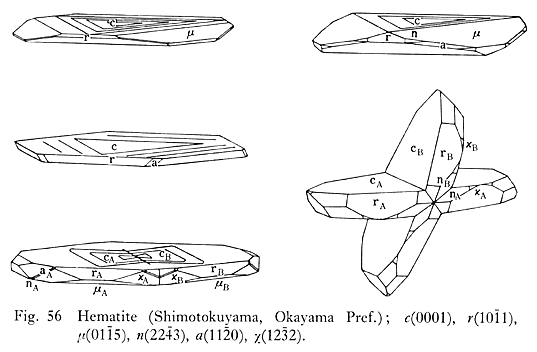
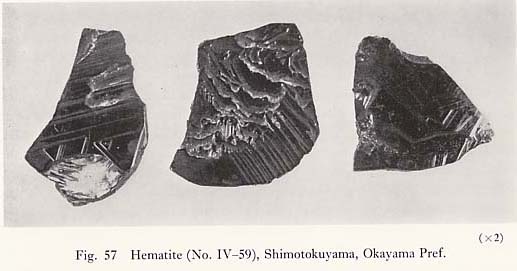
Specimen No. IV-63, from Sagashima Isl., Nagasaki Pref., occurs in drusy cavities in andesite, and forms platy crystals with c(0001) striated parallel to the edge of the prism.
Specimen No. IV-64, from the Tochu Mine, China, occurs in drusy cavities in a quartz vein, and. forms octahedral crystals up to 1 cm in diameter, which are a pseudomorph after magnetite.
Specimens Nos. IV-65 & IV-66, from Ryukan, China, occur in a tremendous bed of sedimentary origin, and forms reddish brown to dark brown coloured botryoidal aggregates of oolitic texture.
Specimen No. IV-67, from Bingham, Alabama, U.S.A., occurs in a tremendous bed of calcareous sediments and forms massive aggregates of fine-grained hematite showing a banded texture.
Specimen No. IV-68, from Minas Geraes, Brazil, occurs in metamorphosed sediments as a rosette aggregate of tabular crystals.
Specimen No. IV-69, from the Jurai Mine, Malaysia, is a weathering product in dark grey massive aggregates.
Ilmenite, FeTiO3, Trigonal, R![]()
< Specimens Nos. IV-70 & IV-71 >
Specimens Nos. IV-70 & IV-71, from Taejeon-ri, Korea, occur as massive aggregates in a granitic gneiss.
Stibiconite, SbSb2O6OH, Cubic, Fd3m
< Specimen No. IV-72 >
Specimen No. IV-72, from the Daiichihinomoto Mine, Kagoshima Pref., occurs as secondary product from stibnite, and forms yellowish powdery incrustations on stibnite needles or in fractures of a stibnite-bearing quartz vein.
Quartz, SiO2, Trigonal, P3121 or P3221
Rock Crystal (Fig. 58)
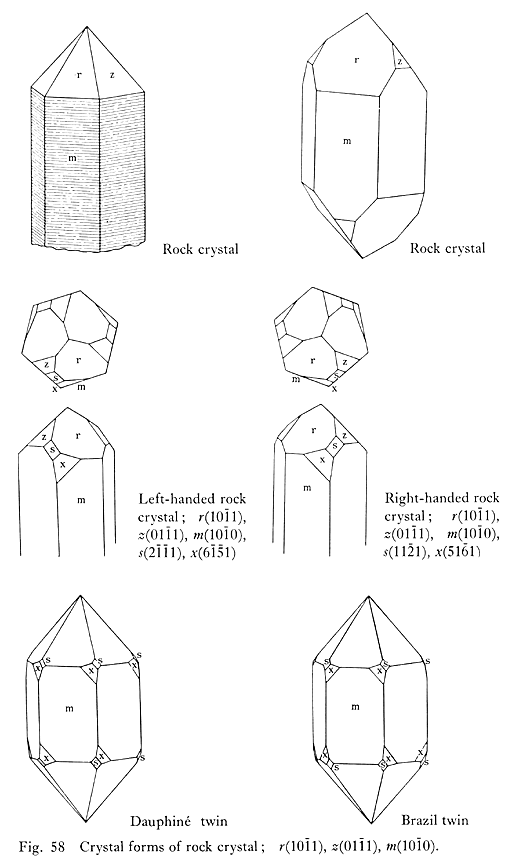
< Specimens No. IV-73—No. IV-123 >
Specimens No. IV-73—No. IV-83, from the Arakawa Mine, Akita Pref., occur in drusy cavities in a quartz vein from an epithermal copper deposit, and form hex-agonal prismatic crystals, sometimes in a group of parallel orientation as in specimen No. IV-75, and scepter-shaped hexagonal prisms such as in specimens Nos. IV-79 & IV-80. The greenish grey colouring of specimens Nos. IV-76 & IV-77 is due to inclusions of minute scales of chlorite.
Specimen No. IV-84, from Tozawa, Fukushima Pref., occurs in a granitic pegmatite as a pink and transparent massive aggregate.
Specimen No. IV-85, from the Takatori Mine, Ibaraki Pref., occurs
in drusy cavities in a quartz vein from a pneumatolytic wolframite deposit,
and forms prismatic crystals with r(10![]() 1)
z(01
1)
z(01![]() 1), m(10
1), m(10![]() 0),
x(51
0),
x(51![]() 1), u(31
1), u(31![]() 1),
s(11
1),
s(11![]() 1) and M(30
1) and M(30![]() 1).
1).
Specimens No. IV-86—No. IV-88, from the Sado Mine, Niigata Pref., are trans-parent to semi-translucent prismatic crystals, and occur in drusy cavities in a quartz vein from an epithermal gold-silver deposit. Fluid inclusions are observed in the crystal of specimen No. IV-88.
Specimens No. IV-89—No. IV-94, from the Otome (Otomezaka) Mine,
Yamanashi Pref., occur in drusy cavities in a pegmatitic quartz vein, and
form a sharp trigonal pyramid as in specimen No. IV-93, and twins after the
Japanese law with (11![]() 2) as twinning
plane in which the axes of the two individuals make an angle of 84°34',
thus forming a pair of coplanar prism faces. The largest twinned crystal in
specimen No. IV-89 measures 7 cm, but its thickness is less than 1 cm (Plate
9, Figs. 59 & 60). The main faces observed are r(10
2) as twinning
plane in which the axes of the two individuals make an angle of 84°34',
thus forming a pair of coplanar prism faces. The largest twinned crystal in
specimen No. IV-89 measures 7 cm, but its thickness is less than 1 cm (Plate
9, Figs. 59 & 60). The main faces observed are r(10![]() 1),
z(01
1),
z(01![]() 1) and m(10
1) and m(10![]() 0).
0).
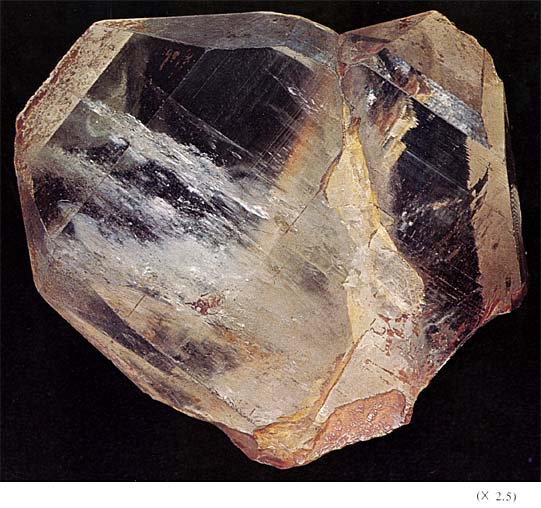
QUARTZ (No. IV-94) (Twinned crystals, Japanese law) Otome Mine, Yamanashi
Pref.
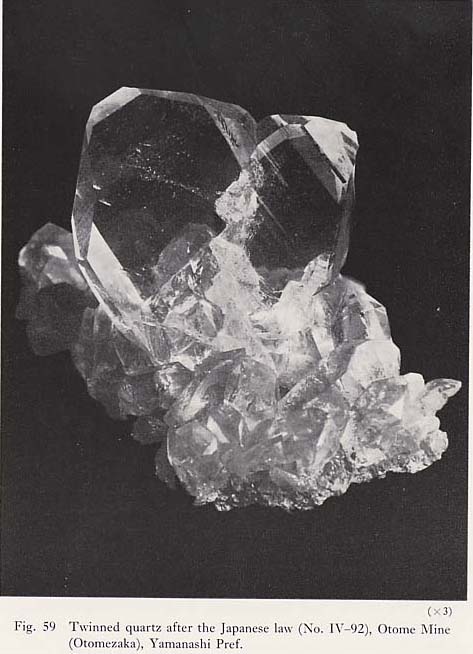
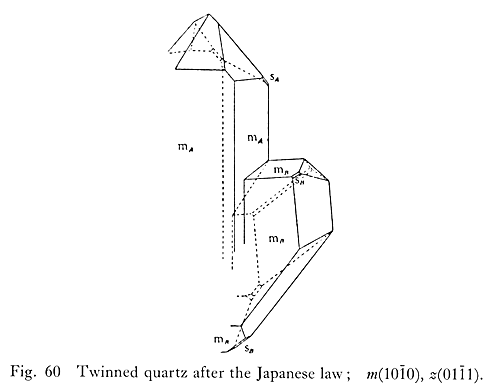
Specimens No. IV-95—No. IV-104, from the Otome (Kurasawa) Mine, Yama-nashi Pref., are the same in occurrence and form as the quartz specimens from Otome-zaka, Yamanashi Pref. Unidentified crystals, greenish grey to pale yellow in colour and acicular in shape, are included in the hexagonal prismatic crystal of specimen No. IV-104.
Specimens Nos. IV-105 & IV-106, from Kurobera, Yamanashi Pref., occur in druses in a granitic pegmatite, and form hexagonal prismatic crystals terminated by pyramidal faces. They are colourless to milky-white.
Specimens No. IV-107—No. IV-110, from Takemori, Yamanashi Pref.,
occur in drusy cavities in a granitic pegmatite, and form transparent hexagonal
columnar crystals containing minute scales of mica (specimen No. IV-108),
brown coloured acicular crystals of tourmaline (specimen No. IV-109), and
sulphur (specimen No. IV-110) (Plate 4).

SULPHUR in quartz (No IV-110) Takemori, Yamanashi Pref.
Specimen No. IV-111, from Obi, Hachiman, Yamanashi Pref., occurs in drusy cavities in a granitic pegmatite, and forms hexagonal prismatic crystals in greenish grey colour due to minute acicular inclusions of pyroxene.
Specimens No. IV-112—No. IV-117, from the Naegi District, Gifu
Pref., occur with feldspar in drusy cavities of a granitic pegmatite. These
crystals are dark grey to black in colour, and form hexagonal prisms and twins
after the Dauphine or Brazil law (specimen No. IV-114), plates on a prism
plane (specimen No. IV-113), and twisted prisms (specimen No. IV-116) (Plate
9).
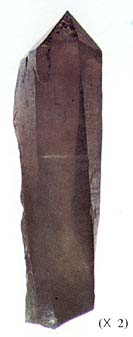
TWISTED SMOKY QUARTZ (No. IV-116) Naegi District, Gifu Pref.
Specimens Nos. IV-118 & IV-119, from the Kanagase Deposit of the Ikuno Mine, Hyogo Pref., occur in drusy cavities in a quartz vein of a xenothermal poly-metallic deposit, form transparent hexagonal prismatic crystals attaining a few centi-meters in length, and are associated with cube-shaped pyrite crystals.
Specimen No. IV-120, from Soranokawa, Kochi Pref., occurs in drusy cavities in a quartz vein, and forms hexagonal prisms sometimes terminated at both ends.
Specimen No. IV-121, from Daisen, Fukuoka Pref., is a pale pink coloured and transparent mass occurring in a granitic pegmatite.
Specimen No. IV-122, from Moonam, Korea, is a group of milky-white hexagonal columnar crystals and heart-shaped flattened twins after the Japanese law, found in drusy parts of a garnet skarn in a contact metasomatosed deposit.
Specimen No. IV-123, from Brazil, is transparent. It has been cut and ground into an ellipse-shaped cabochon.
" Pseudomorphs "
< Specimens No. IV-124—No. IV-138 >
Specimen No. IV-124, from Shibetoro, Kunashiri Isl., occurs in drusy cavities in a white massive aggregate of fine-grained quartz, and forms rhombic prismatic pseudomorphs after barite with a hollow space inside.
Specimens No. IV-125—No. IV-135, from the Arakawa Mine, Akita
Pref., occur in drusy cavities in a quartz vein from an epithermal copper
deposit. The spscimens composed of massive quartz form pseudomorphs after
barite in the form of a rhombic prism in which dissolved barite has left a
hollow space behind, and the pseudomorphs are afterward covered with groups
of small needles-shaped quartz. They are associated with chalcopyrite, pyrite
and chlorite as minute inclusions. The largest of the pseudomorphs measures
20 cm in length and 3 cm in the longer diameter of the cross section (Fig.
61).
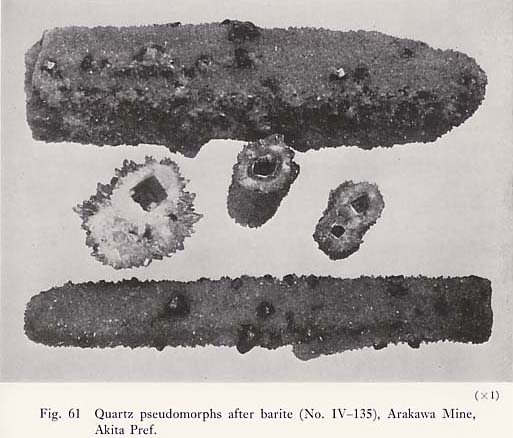
Specimen No. IV-136, from the Uyashinai Deposit of the Arakawa Mine, Akita Pref., occurs as tabular pseudomorphs in drusy cavities in a quartz vein.
Specimen No. IV-137, from the Takatama Mine, Fukushima Pref., occurs in drusy cavities in a quartz vein of an epithermal gold-silver deposit, and forms tabular pseudomorphs after calcite.
Specimen No. IV-138, from the Ushio Deposit Oguchi Mine, Kagoshima Pref., occurs as tabular pseudomorphs in drusy cavities of a quartz vein of an epithermal gold-silver deposit.
Amethyst
< Specimens No. IV-139—No. IV-157 >
Specimens No. IV-139—No. IV-150, from the Arakawa Mine, Akita Pref., occur in drusy cavities among milky crystalline quartz in a quartz vein of an epithermal copper-lead-zinc deposit. They are groups of pale violet prismatic crystals terminated by pyramids and 4 cm long. Associated minerals are chalco-pyrite, sphalerite, chlorite, hematite and calcite.
Specimen No. IV-151, from Obara, Miyagi Fref., is isolated hexagonal
columnar crystals from a quartz vein, pale purple in colour and transparent
(Plate 9).
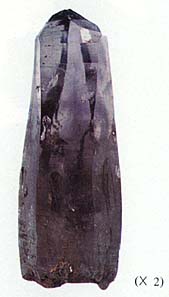
AMETHYST (No. IV-151) Ohara Mine, Miyagi Pref.
Specimen No. IV-152, from the Ashio Mine, Tochigi Pref., occurs in drusy cavities in a chalcopyrite-bearing quartz vein, and is prismatic crystals up to 2 cm in length, pale purple in colour and transparent.
Specimen No. IV-153, from the Yusenji Mine, Ishikawa Pref., occurs in drusy cavities in a quartz vein of an epithermal copper-lead-zinc deposit. The crystals are in the form of a hexagonal prism up to 4 cm in length, pale purple in colour and transparent.
Specimen No. IV-154 from the Ogoya Mine Ishikawa Pref., forms a group of pale violet hexagonal prismatic crystals terminated by pyramids, and occurs in drusy cavities of a quartz vein of an epithermal copper-lead-zinc deposit.
Specimens No. IV-155—No, IV-157, from Packam-san, Korea, occur
in druses in a quartz vein cutting through gneiss, and form reddish purple
to deep purple crystals with z(01![]() 1),
r(10
1),
r(10![]() 1) and m(10
1) and m(10![]() 0).
0).
Jasper
< Specimens No. IV-158—No. IV-160 >
Specimens No. IV-158—No. IV-160, from Tamatsukuri, Shimane Pref., occur as segregation product filling cavities of a rhyolitic rock, and form massive aggregates of banded texture. They are sage-green to dark green.
Agate
< Specimens No. IV-161—No. IV-164>
Specimens No. IV-161—No. IV-164, from Chinkobe, Hokkaido, occur as nodular aggregates filling amygdules in rhyolite, and show concentric texture with an alter-nating banding of creamy white to white parts and yellowish brown to reddish brown parts as in specimens Nos. IV-161 & IV-162. Specimen No. IV-163 is botryoidal aggregates like a mass of pale brownish wax.
Chalcedony
< Specimens No. IV-165-No. IV-179 >
Specimen No. IV-165, from a small island, 73 km west of Muroran City, Hokkai-dÖ, occurs from the sea shore as pebbles of grey coloured banded texture.
Specimen No. IV-166, from the Hirokunai Mine, Akita Pref., occurs as sphe-lurites filling amygdules in rhyolite.
Specimen No. IV-167, from Ogunimachi, Yamagata Pref., occurs as spherulitic masses in an external appearance like a circular bi-cone, filling amygdules in rhyolite and about 1 cm in diameter. This outward shape of the mineral resembles a counter (" tama " or " dama ") of the Japanese abacus, " soroban ", thus the name " sorobandama " has been given to it.
Specimens No. IV-168—No. IV-175, from Hosaka, Fukushima Pref.,
are botryoi-dal masses or in the same peculiar shape as that of specimen No.
IV-167, and occur in amygdules in rhyolite. The inner part of the specimens
is surrounded by white to grey and translucent chalcedony and sometimes exhibits
opal-like schillerization (Fig. 62).
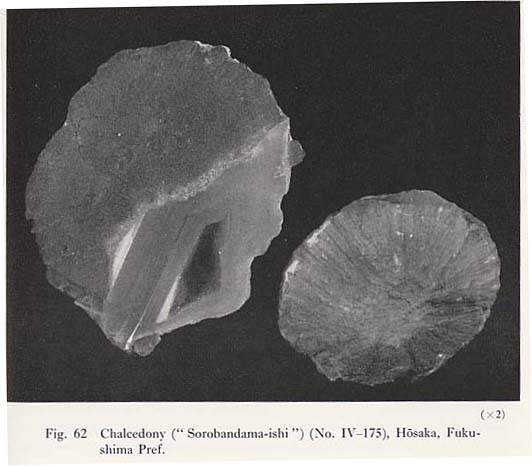
Specimen No. IV-176, from the Akatani Mine, Niigata Pref., occurs as white coloured fine-grained masses in a spheluritic form, filling amygdules in rhyolite.
Specimen No. IV-177, from Takinoura, Anijima Isl., Tokyo, occurs as vein mineral forming a massive aggregate in andesite.
Specimen No. IV-178, from Ogiura, Chichijima Isl., Tokyo, occurs as grey sphelurites filling an amygdule in andesite.
Specimen No. IV-179, from Hakamadake, Niigata Pref., is botryoidal or peculiar-shaped masses so-called " Sorobandama " filling amygdules in rhyolite.
Opal
< Specimens No. IV-180—No. IV-183 >
Specimen No. IV-180, from the Yusenji Mine, Ishikawa Pref., occurs in an amygdule in rhyolite as a massive aggregate showing bluish grey colour.
Specimens No. IV-181—No. IV-183, from Akase, Ishikawa Pref., occur as light yellow to yellowish brown masses with conchoidal fractures in amygdules in rhyolite. Specimen No. IV-183 is a bluish white glassy mass with conchoidal fracture. Though rarely, they show schillerization in greenish colour.
Siliceous oolite
< Specimens No. IV-184—No. IV-189 >
Specimens No. IV-184—No. IV-186, from Yunotai, Akita Pref., occur as precipitation product in a hot spring, and form aggregates of small and white spherulites up to 3 mm in diameter.
Specimen No. IV-187, from the Onikobe Hot Spring, Miyagi Pref., occurs as precipitation product from the hot spring, and forms a banded siliceous sinter com-posed of white oolites.
Specimens Nos. IV-188 & IV-189, from Tateyama, Shinyu Hot Spring,
Toyama Pref., occur in oolitic aggregates of transparent spherulites as precipitation
product in the hot spring. The individual spherulites, reaching about 2 cm
across, look like well-selected pearl grains (Plate 8).

OOLITIC SILICA (No. IV-189) Tateyama, Toyama Pref.
Tridymite, SiO2, Rhombic, P212121 or C2221
< Specimens Nos. IV-190 & IV-191 >
Specimen No. IV-190, from Ishigamiyama, Kumamoto Pref., occurs in cavities in andesite. The crystals are in small hexagonal scales, often in aggregation, white in colour and translucent.
Specimen No. IV-191, from Onohana, Nagano Pref., occurs in cavities in andesite, and forms minute hexagonal scales attaining 1 mm across, and their aggregates.
Rutile, TiO2, Tetragonal, P42/mnm
< Specimens No. IV-192—No, IV-196> (Fig. 63)

Specimens No. IV-192—No. IV-194, from Bizan, Tokushima Pref., occur in a massive quartz vein cutting through a schist in the Sambagawa metamorphic series, and form crystals with a(100), m(110), s(111) and e(101), and elbow-shaped twins as well. Thin platy hematite is associated.
Specimen No. IV-195, from Brazil, occurs in a placer deposit, forming short prismatic crystals with curved faces owing to erosion.
Specimen No. IV-196, from Sangjin-dong, Korea, forms a short prismatic crystal 1 cm in length. The mode of occurrence unknown.
Cassiterite, SnO2, Tetragonal, P42/mnm
< Specimens No. IV-197—No. IV-211 >
Specimens No. IV-197—No. IV-204, from the Takatori Mine, Ibaraki Pref., occur in a quartz vein bearing fluorite and sericite in a pneumatolytic tin-tungsten deposit, and form black short prismatic crystals. Faces observed are a(100), m(110), s(111) and e(101). Elbow-shaped twins up to 1 cm in length sometimes appear.
Specimens Nos. IV-205 & IV-206, from the Naegi District, Gifu Pref,
occur in a placer tin deposit, forming short prismatic crystals. Cyclic twins
and some other annexed forms appear (Fig. 64).

Specimen No. IV-207, from the Akenobe Mine, Hyogo Pref, occurs in a wolframite-bearing quartz vein, and is deep brown aggregates with " colloform " texture. Scheelite is associated.
Specimens No. IV-208—No. IV-210, from the Mitate Mine, Miyazaki Pref, occur in a quartz vein cutting through chert, and form brown short prisms attaining a few millimeters long on crystalline quartz. Their common form is a combination of m(110), z(321) and s(111).
Specimen No. IV-211, from the Taehwa Mine, Korea, occurs in a quartz vein from a pegmatitic tin-tungsten deposit, and forms deep brown short prismatic crystals with m(110), a(100), e(101) and s(111).
Anatase,TiO2, Tetragonal, I41/amd
< Specimen No. IV-212 >
Specimen No. IV-212, from Switzerland, occurs in drusy cavities in the quartz vein, namely the "Alpine vein ", in schist or gneiss, and in association with crystals of adularia. It consists of small crystals with c(001) and p(011).
Tellurite, TeO2, Rhombic, Pbca
< Specimens No. IV-213—No. IV-218 >
Specimens No. IV-213—No. IV-218, from the Rendaiji Mine, Shizuoka
Pref occur in a tellurium-bearing quartz vein from an epithermal gold-silver
deposit, and form thin incrustations and small tabular crystals, which are
found in drusy cavities in ceramic-like massive quartz and associated with
native tellurium, pale yellow and transparent. Faces observed on the crystals
are b(010), n(430), i(10.21.6), e(131) and g(0![]() 4)
(Fig. 65).
4)
(Fig. 65).
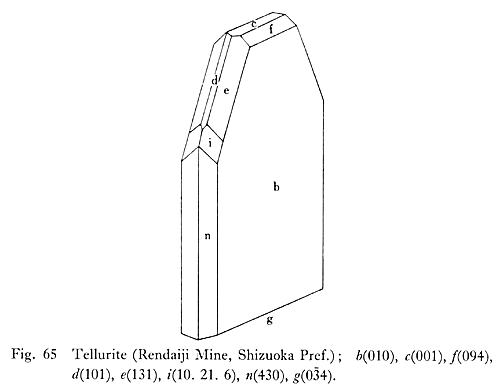
Columbite, (Fe, Mn) (Nb, Ta)2O6 Rhombic, Pbcn
< Specimens No. IV-219—No.IV-226 >
Specimens No. IV-219—No. IV-222, from Ishikawayama, Fukushima Pref are black tabular crystals reaching 3 cm in length, and occur in a granitic pegmatite. Faces observed are a(100), m(110), b(010), c(001), u(133) and e(021).
Specimens Nos. IV-223 & IV-224, from the Ishikawa District, Fukushima
Pref., occur in a granitic pegmatite, and form prismatic crystals with a(100),
b(010) and e(100), and 2 × 3 × 10 mm in size. They are black in
colour and show submetallic lustre (Fig. 66)
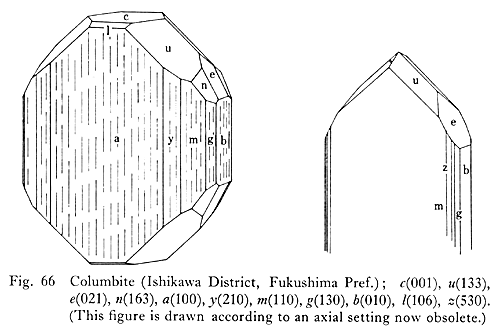
Specimen No. IV-225, from Idogami, Ishikawa District, Fukushima Pref, occurs in a granitic pegmatite as a black coloured tabular crystal with well-developed faces of a(l00), m(110), b(010), c(001), u(133) and e(021). The crystal is about 40 × 25 × 5 mm in size.
Specimen No. IV-226, from Yamanoo, Ibaraki Pref., occurs in a granitic pegmatite, and forms black tabular crystals with a(100) m(110) b(010) c(001) u(133) and e(021), reaching 1 cm in diameter.
Samarskite, (Y, U, Fe)NbO4, Monoclinic, C2/c
< Specimen No. IV-227 >
Specimen No. IV-227, from Takayama, Naegi District, Gifu Pref, occurs in a placer tin deposit, and is small rounded grains reaching a few millimeters across.
Fergusonite, YNbO4, Tetragonal, I41/a
< Specimens No. IV-228—No. IV-230 >
Specimen No. IV-228, from Tadachi, Nagano Pref., is small short prismatic crystals, a few millimeters in length and included in orthoclase in a granitic pegmatite. Faces observed are c(001), s(111) and g(320).
Specimen No. IV-229, from the Naegi District, Gifu Pref, occurs in a placer tin deposit derived from a granitic pegmatite, and forms black granular crystals and their radial aggregates.
Specimen No. IV-230, from Mategata, Ehime Pre., occurs in orthoclase in a granitic pegmatite, forming black short prismatic crystals with c(001) s(111) and ,g(320).
Diaspore, α-AlOOH, Rhombic, Pbnm
< Specimens No. IV-231—No. IV-234 >
Specimens Nos. IV-231 & IV-232, from Mitsuishi, Okayama Pref, occur
in a hydrothermal alteration pyrophyllite deposit, forming nodular balls composed
of pyrophyllite and fine-grained diaspore in a concentric texture (Fig. 67).
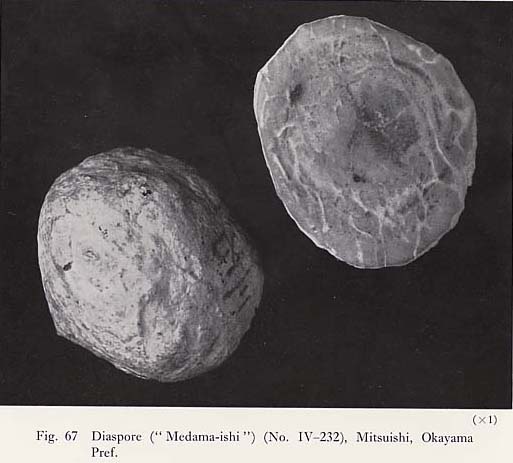
Specimens Nos. IV-233 & IV-234, from the Shokozan Mine, Hiroshima Pref, occur in association with massive pyrophyllite in a hydrothermal alteration pyro- phyllite deposit, forming granular crystals with perfect cleavage on (010). The crystals measure a few millimeters in diameter.
Limonite, Iron hydroxide, Cryptocrystalline
< Specimens No. IV-235-No. IV-237 >
Specimen No. IV-235, from the Arakawa Mine, Akita Pref, occurs in an oxidized chalcopyrite-quartz vein, forming pseudomorphs after chalcopyrite crystals.
Specimen No. IV-236, from the Iwami Mine, Tottori Pref, is a secondary product from a weathered copper ore, and forms slaggy aggregates reddish brown to brown in colour.
Specimen No. IV-237, from Shincheon, Korea, occurs as secondary mineral in an iron deposit, forming an amorphous mass.
Goethite, α-FeOOH, Rhombic, Pbnm
< Specimens Nos. IV-238 & IV239 >
Specimens Nos. IV-238 & IV-239, from the Haseong Mine, Korea, occur in a bedded iron deposit, forming stalagmitic botryoidal aggregates of acicular crystals with a radial texture.
Manganite, Υ-MnOOH, Monoclinic, B21/d
< Specimens No. IV-240—No. IV-242 >
Specimen No. IV-240, from the Meppu Mine, Hokkaido, occurs in a sedimentary
manganese deposit precipitated from a low-temperature hot spring, and forms
botryoidal aggregates (Fig. 68).
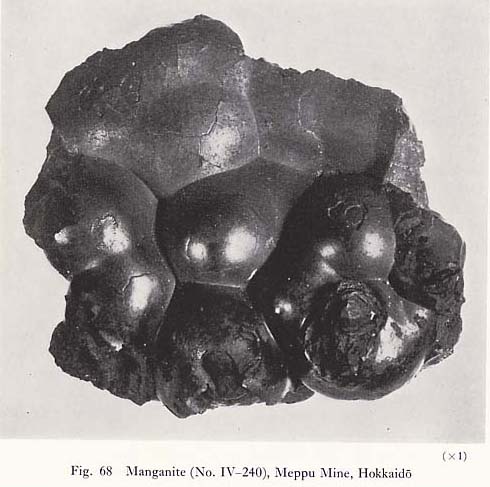
Specimen No. IV-241, from the Owani Mine, Aomori Pref, occurs in a
sedimentary manganese deposit, and forms an aggregates of slender prismatic
crystals, black in colour and semimetallic in lustre (Fig. 69). In its drusy
parts, some crystals up to 1 cm in length grow. Faces observed on these crystals
are c(001), m(110) and b(010).

Specimen No. IV-242, from the Hirotani Mine, Niigata Pref, occurs in a sedimentary manganese deposit, and forms a massive aggregate of granular crystals with perfect cleavage on (010).